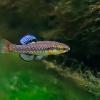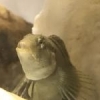Hi everyone! I want to set up a 10 gallon macroalgae tank...can you suggest any saltwater natives for such smallish quarters? I would appreciate it if the fish in question did not have a pelagic larval stage, so I would be able to raise it easily on the baby brine shrimp and walter worms I am already culturing. Thank you ![]()

10 gallon saltwater fishes
#1

Posted 22 September 2020 - 09:37 AM
#2

Posted 22 September 2020 - 12:56 PM
Instead of a full saltwater, did you consider doing brackish? Here's a link to something you could do on a smaller scale. You could throw a couple different killies in there along with some blennies, and even crabs if you wanted to. You're limited with such a small tank, but with killies getting to 3 inches and blennies not really getting past 4 inches, you could house a handful of fish in this tank.
#3

Posted 22 September 2020 - 01:52 PM
Instead of a full saltwater, did you consider doing brackish? Here's a link to something you could do on a smaller scale. You could throw a couple different killies in there along with some blennies, and even crabs if you wanted to. You're limited with such a small tank, but with killies getting to 3 inches and blennies not really getting past 4 inches, you could house a handful of fish in this tank.
Cool! I had wanted saltwater for the macroalgae, though (and relatively few macroalgae will do well in brackish water).
#4

Posted 22 September 2020 - 02:04 PM
Under the right conditions, Ulva lactuca can thrive in brackish to marine tanks. The oyster reef tank above, as well as my tanks, are brackish with specific gravity ranging from 1.009 to 1.019. You can search this site to find info on my tanks. I've kept Ulva, but not at optimal conditions. With good lighting and nutrients, it will thrive.
There is a lot of good info on keeping macros and grasses in a marine tank (not quite full seawater, in this case) on this Reef Central thread:
http://www.reefcentr...d.php?t=2678002
As far as fish in a 10 gallon, it depends on the size of the fish and how many you keep.
Here is a video of my last oyster reef tank set up with blennies, gobies and skilletfish. I kept Ulva in this tank as well. This tank is a 20g tank. All of the fish were adults during the time it was filmed.
https://www.youtube....AX4H5PnVhM&t=1s
If you want fish that don't get big, I'm keeping a 20g tank that contains 9 rainwater killifish, 4 four-spine sticklebacks, and three naked gobies, two live oysters, several live mussels, a bunch of wild caught anemones, several grass shrimp, and a half dozen mud crabs (2 species). You could easily halve that stocking list for a 10g version of the tank. I'll try and get a video of that tank done soon. BTW, the four sticklebacks get along together just fine. I've kept them for 6 months now.
Kevin Wilson
#5

Posted 22 September 2020 - 03:41 PM
Under the right conditions, Ulva lactuca can thrive in brackish to marine tanks. The oyster reef tank above, as well as my tanks, are brackish with specific gravity ranging from 1.009 to 1.019. You can search this site to find info on my tanks. I've kept Ulva, but not at optimal conditions. With good lighting and nutrients, it will thrive.
There is a lot of good info on keeping macros and grasses in a marine tank (not quite full seawater, in this case) on this Reef Central thread:
http://www.reefcentr...d.php?t=2678002
As far as fish in a 10 gallon, it depends on the size of the fish and how many you keep.
Here is a video of my last oyster reef tank set up with blennies, gobies and skilletfish. I kept Ulva in this tank as well. This tank is a 20g tank. All of the fish were adults during the time it was filmed.
https://www.youtube....AX4H5PnVhM&t=1s
If you want fish that don't get big, I'm keeping a 20g tank that contains 9 rainwater killifish, 4 four-spine sticklebacks, and three naked gobies, two live oysters, several live mussels, a bunch of wild caught anemones, several grass shrimp, and a half dozen mud crabs (2 species). You could easily halve that stocking list for a 10g version of the tank. I'll try and get a video of that tank done soon. BTW, the four sticklebacks get along together just fine. I've kept them for 6 months now.
Aside from the killies, do you think any of those could feasibly be bred by a standard hobbyist?
#6

Posted 22 September 2020 - 08:10 PM
Blennies, gobies and skilletfish produce fish larvae. You can raise them, but it is pretty involved, best with a culture of rotifers, and later larger foods like bbs. If you are interested in that, I can get you instructions on how to raise them. It's not easy though.
I think that perhaps the best bet would be sticklebacks. I have yet to breed them. I have four-spined sticklebacks, but haven't seen much about breeding them in captivity. There are three spine sticklebacks in my state, but I have yet to catch them. There is info on the web about breeding them. I would think that the process for the four-spined would be similar. Here is one useful post describing how to do it:
Reasonably easy. Separate males and females. Feed a high protein diet. Isolate males and provide nesting material. I use small lengths of green cotton. Once the male builds his best, introduce a female. Once she lays , remove her and allow the male to fan and tend the nest. Once the young hatch, remove the male. Feed on infusorians.
Kevin Wilson
#7

Posted 23 September 2020 - 07:34 AM
Blennies, gobies and skilletfish produce fish larvae. You can raise them, but it is pretty involved, best with a culture of rotifers, and later larger foods like bbs. If you are interested in that, I can get you instructions on how to raise them. It's not easy though.
I think that perhaps the best bet would be sticklebacks. I have yet to breed them. I have four-spined sticklebacks, but haven't seen much about breeding them in captivity. There are three spine sticklebacks in my state, but I have yet to catch them. There is info on the web about breeding them. I would think that the process for the four-spined would be similar. Here is one useful post describing how to do it:
OK. I am actually looking into culturing Parvocalanus copepods if I find myself trying to keep fishes with pelagic larvae, inasmuch as practically all saltwater larvae do better on copepod nauplii than on rotifers.
#8

Posted 23 September 2020 - 10:45 AM
That's cool. My blennies, skilletfish and gobies laid eggs all the time. I had fish larvae constantly swimming around the tank and in the surface film all the time, it seemed. I couldn't really tell the difference between the three species larvae with just a magnifying glass. But, I suspect that, since the blennies bred most often, that most of the time, they were larval blennies.
Since striped blennies (and also feather blennies) get to be 4-5" long, I think that a pair of males and one female would be find, with maybe a couple skilletfish and gobies mixed it. I tend to stock heavily though. I am building a larger 100g oyster reef tank, and may move the rainwater killies and sticklebacks in with the benthic fish. I may just keep the 20g long for the sticklebacks and rainwater killies. Sheepshead minnows also might be a good bet for you. I've never bred them, but, I would think that they would be pretty easy, if you wanted slightly bigger fish.
I'm happy with the rainwater killies. They have a little bit of color, school and get along nicely, and act as nice dither fish for my current tank. They have yet to lay eggs that I can tell yet. I don't think it will be long though. I guess that I need to make a mop for them.
Kevin Wilson
#9

Posted 20 October 2020 - 07:02 AM
I'm happy with the rainwater killies. They have a little bit of color, school and get along nicely, and act as nice dither fish for my current tank. They have yet to lay eggs that I can tell yet. I don't think it will be long though. I guess that I need to make a mop for them.
I always used a mop when breeding rainwater killies. Even though I bred them in full saltwater, it was the same as the typical breeding process for most freshwater plant-spawning killifish. The difference came when feeding the newly hatched fry - I used more of a feeding approach that I would use with clownfish (e.g., rotifers, plankton, etc.).
Reply to this topic
0 user(s) are reading this topic
0 members, 0 guests, 0 anonymous users









